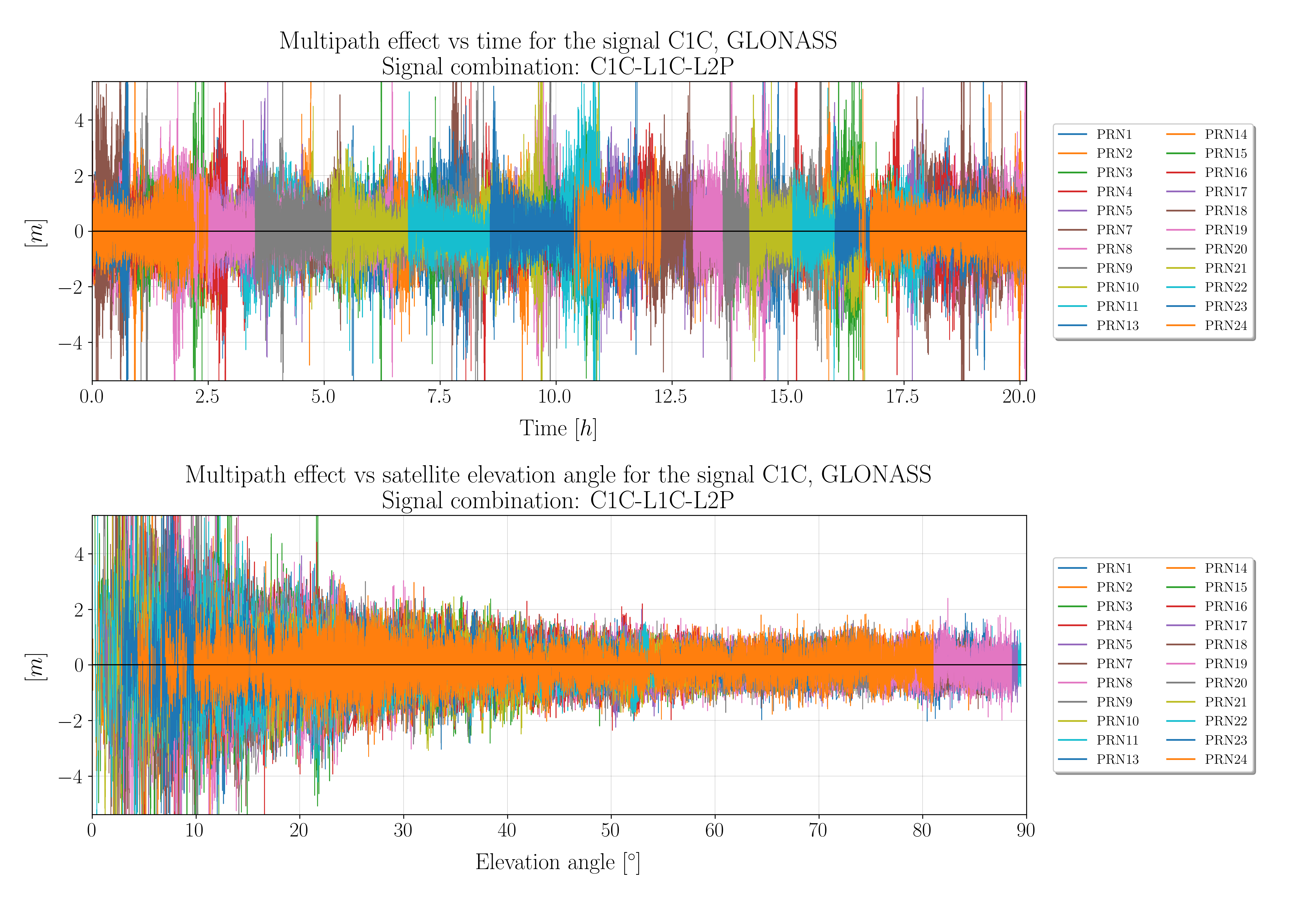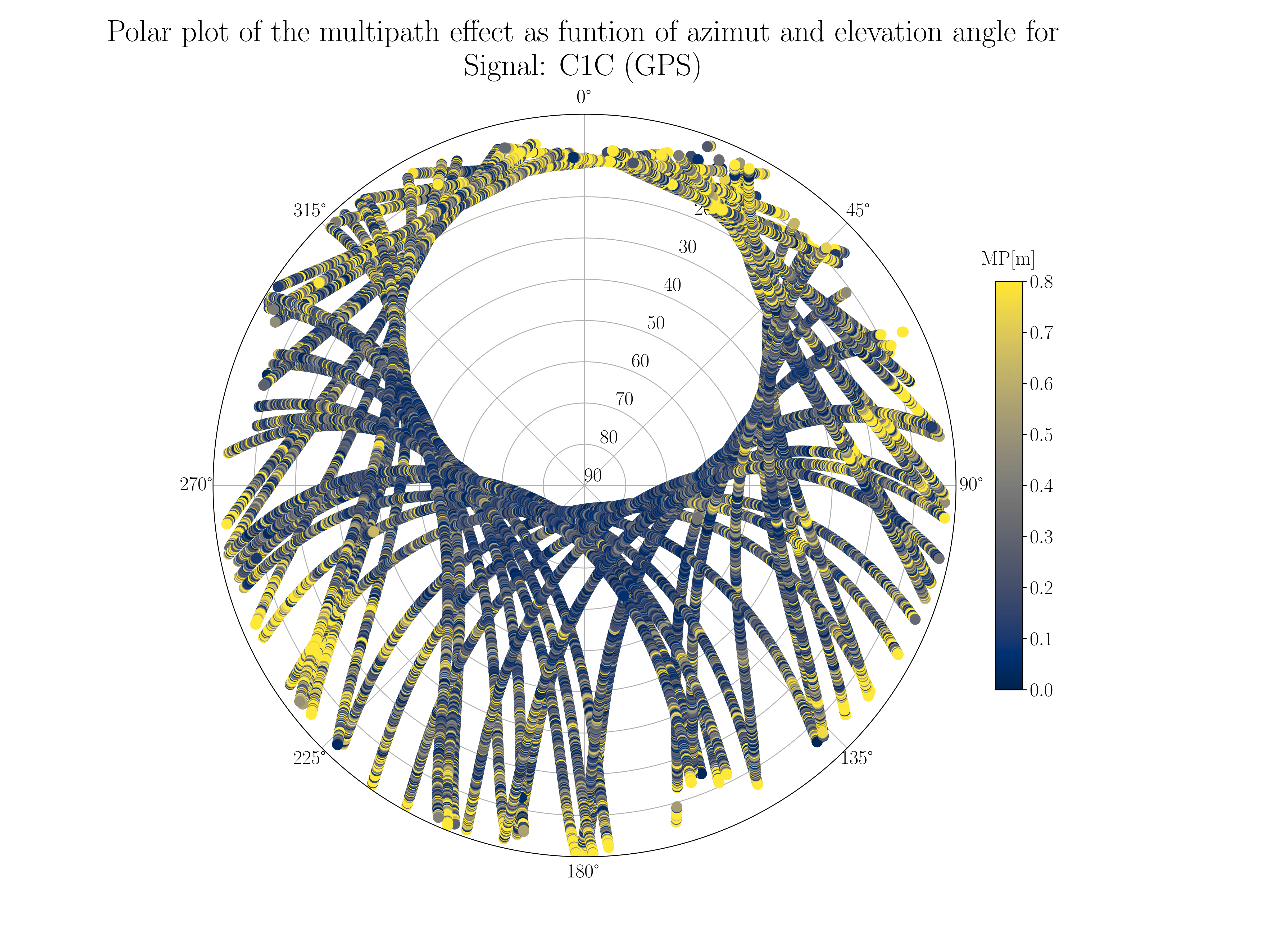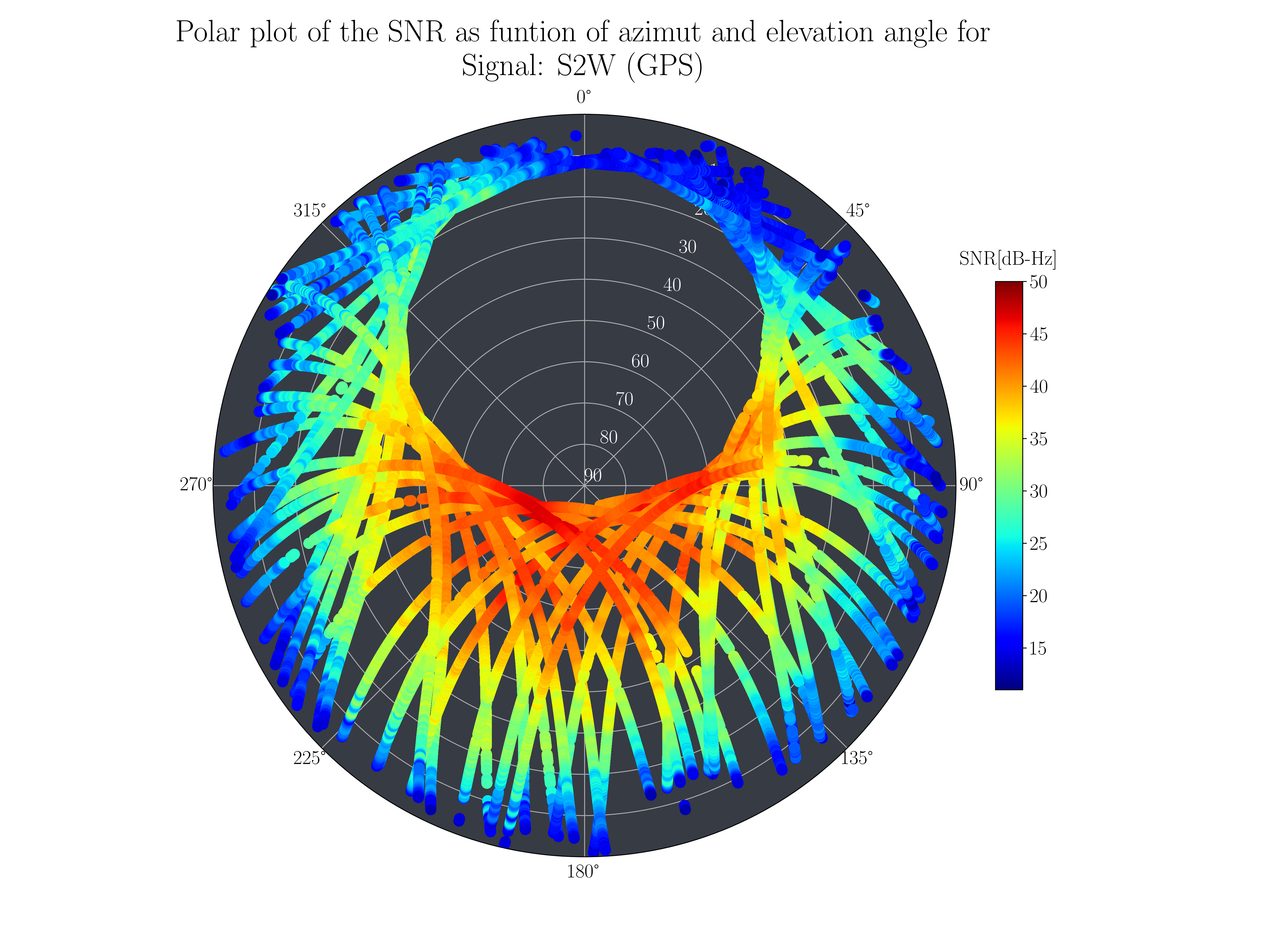
Security News
Security Community Slams MIT-linked Report Claiming AI Powers 80% of Ransomware
Experts push back on new claims about AI-driven ransomware, warning that hype and sponsored research are distorting how the threat is understood.
gnssmultipath
Advanced tools
A python software that provides comprehensive solutions for GNSS multipath analysis.
GNSS Multipath Analysis is a software tool for analyzing the multipath effect on Global Navigation Satellite Systems (GNSS). The core functionality is based on the MATLAB software GNSS_Receiver_QC_2020, but has been adapted to Python and includes additional features. A considerable part of the results has been validated by comparing the results with estimates from RTKLIB. This software will be further developed, and feedback and suggestions are therefore gratefully received. Don't hesitate to report if you find bugs or missing functionality. Either by e-mail or by raising an issue here in GitHub. Contributions are also welcome!
To install the software to your Python environment using pip:
pip install gnssmultipath
Note: In the example plots, TEX is used to get prettier text formatting. However, this requires TEX/LaTex to be installed on your computer. The program will first try to use TEX, and if it's not possible, standard text formatting will be used. So TEX/LaTex is not required to run the program and make plots.
sudo apt-get install texlive-full brew install --cask mactexTo run the GNSS Multipath Analysis, import the main function and specify the RINEX observation and navigation/SP3 files you want to use. To perform the analysis with default settings and by using a navigation file:
from gnssmultipath import GNSS_MultipathAnalysis
outputdir = 'path_to_your_output_dir'
rinObs_file = 'your_observation_file.XXO'
rinNav_file = 'your_navigation_file.XXN'
analysisResults = GNSS_MultipathAnalysis(rinObs_file,
broadcastNav1=rinNav_file,
outputDir=outputdir)
If you have a SP3 file, and not a RINEX navigation file, you just replace the keyword argument broadcastNav1 with sp3NavFilename_1.
Neville's algorithm.GNSSPositionEstimator class.$$ \dot{I} = \frac{1}{\alpha-1}\left(\Phi_1 - \Phi_2\right)/\Delta t $$
$$ d\Phi_1R_1 = \Phi_1 - R_1 $$
The threshold values can be set by the user, and the default values are set to $0.0667 [\frac{m}{s}]$ and $6.67[\frac{m}{s}]$ for the ionospheric residuals and code-phase combination respectively.
$$MP_1 = R_1 - \left(1+\frac{2}{\alpha - 1}\right)\Phi_1 + \left(\frac{2}{\alpha - 1}\right)\Phi_2$$
where $R_1$ is the code observation on band 1, $\Phi_1$ and $\Phi_2$ is phase observation on band 1 and band 2 respectively. Furthermore $\alpha$ is the ratio between the two frequency squared
$$\alpha=\frac{{f}^2_1}{{f}^2_2}$$
$$RMS=\sqrt{\frac{\sum\limits_{i=1}^{N_{sat}}\sum\limits_{j=1}^{N_{epohcs}} MP_{ij}}{N_{est}}}$$
For the weighted RMS value, the satellite elevation angle is used in a weighting function defined as
$$w =\frac{1}{4sin^2\beta}$$
for every estimates with elevation angle $\beta$ is below $30^{\circ}$ and $w =1$ for $\beta > 30^{\circ}$.
Ionospheric delay wrt time and zenith mapped ionospheric delay (combined)

The Multipath effect plotted wrt time and elevation angle (combined)

Barplot showing RMS values for each signal and system

Polar plot of the multipath effect as function of elevation angle and azimuth

Polar plot of each observed satellite in the system

Signal-To-Noise Ratio (SNR) plotted wrt time and elevation angle (combine)

Polar plot of Signal-To-Noise Ratio (SNR)

The GNSS_MultipathAnalysis function accepts several keyword arguments that allow for detailed customization of the analysis process. Below is a list of the first five arguments:
rinObsFilename (str):
Path to the RINEX 3 observation file. This is a required argument.
broadcastNav1 (Union[str, None], optional):
Path to the first RINEX navigation file. Default is None.
broadcastNav2 (Union[str, None], optional):
Path to the second RINEX navigation file (if available). Default is None.
broadcastNav3 (Union[str, None], optional):
Path to the third RINEX navigation file (if available). Default is None.
broadcastNav4 (Union[str, None], optional):
Path to the fourth RINEX navigation file (if available). Default is None.
sp3NavFilename_1 (Union[str, None], optional):
Path to the first SP3 navigation file. Default is None.
sp3NavFilename_2 (Union[str, None], optional):
Path to the second SP3 navigation file (optional). Default is None.
sp3NavFilename_3 (Union[str, None], optional):
Path to the third SP3 navigation file (optional). Default is None.
desiredGNSSsystems (Union[List[str], None], optional):
List of GNSS systems to include in the analysis. For example, ['G', 'R'] to include only GPS and GLONASS. Default is all systems (None).
phaseCodeLimit (Union[float, int, None], optional):
Critical limit that indicates cycle slip for phase-code combination in m/s. If set to 0, the default value of 6.667 m/s will be used. Default is None.
ionLimit (Union[float, None], optional):
Critical limit indicating cycle slip for the rate of change of the ionospheric delay in m/s. If set to 0, the default value of 0.0667 m/s will be used. Default is None.
cutoff_elevation_angle (Union[int, None], optional):
Cutoff angle for satellite elevation in degrees. Estimates with elevation angles below this value will be excluded. Default is None.
outputDir (Union[str, None], optional):
Path to the directory where output files should be saved. If not specified, the output will be generated in a sub-directory within the current working directory. Default is None.
plotEstimates (bool, optional):
Whether to plot the estimates. Default is True.
plot_polarplot (bool, optional):
Whether to generate polar plots. Default is True.
include_SNR (bool, optional):
If set to True, the Signal-to-Noise Ratio (SNR) from the RINEX observation file will be included in the analysis. Default is True.
save_results_as_pickle (bool, optional):
If True, the results will be saved as a binary pickle file. Default is True.
save_results_as_compressed_pickle (bool, optional):
If True, the results will be saved as a binary compressed pickle file using zstd compression. Default is False.
write_results_to_csv (bool, optional):
If True, a subset of the results will be exported as a CSV file. Default is True.
output_csv_delimiter (str, optional):
The delimiter to use for the CSV file. Default is a semicolon (;).
nav_data_rate (int, optional):
The desired data rate for ephemerides in minutes. A higher value speeds up processing but may reduce accuracy. Default is 60 minutes.
includeResultSummary (Union[bool, None], optional):
Whether to include a detailed summary of statistics in the output file, including for individual satellites. Default is None.
includeCompactSummary (Union[bool, None], optional):
Whether to include a compact overview of statistics in the output file. Default is None.
includeObservationOverview (Union[bool, None], optional):
Whether to include an overview of observation types for each satellite in the output file. Default is None.
includeLLIOverview (Union[bool, None], optional):
Whether to include an overview of LLI (Loss of Lock Indicator) data in the output file. Default is None.
use_LaTex (bool, optional):
If True, LaTeX will be used for rendering text in plots, requiring LaTeX to be installed on your system. Default is True.
dict):
A dictionary containing the results of the analysis for all GNSS systems.pip install gnssmultipath.This project is licensed under the MIT License - see the LICENSE file for details.
from gnssmultipath import GNSS_MultipathAnalysis
rinObs_file = 'OPEC00NOR_S_20220010000_01D_30S_MO_3.04'
SP3_file = 'SP3_20220010000.eph'
analysisResults = GNSS_MultipathAnalysis(rinObsFilename=rinObs_file, sp3NavFilename_1=SP3_file)
from gnssmultipath import GNSS_MultipathAnalysis
# Input arguments
rinObs_file = 'OPEC00NOR_S_20220010000_01D_30S_MO_3.04'
rinNav_file = 'BRDC00IGS_R_20220010000_01D_MN.rnx'
output_folder = 'C:/Users/xxxx/Results_Multipath'
cutoff_elevation_angle = 10 # drop satellites lower than 10 degrees
nav_data_rate = 60 # desired datarate for ephemerides (to improve speed)
analysisResults = GNSS_MultipathAnalysis(rinObsFilename=rinObs_file,
broadcastNav1=rinNav_file,
include_SNR=True,
outputDir=output_folder,
nav_data_rate=nav_data_rate,
cutoff_elevation_angle=cutoff_elevation_angle)
from gnssmultipath import GNSS_MultipathAnalysis
outputdir = 'path_to_your_output_dir'
rinObs = "OPEC00NOR_S_20220010000_01D_30S_MO_3.04_croped.rnx"
# Define the path to your RINEX navigation file
rinNav1 = "OPEC00NOR_S_20220010000_01D_CN.rnx"
rinNav2 = "OPEC00NOR_S_20220010000_01D_EN.rnx"
rinNav3 = "OPEC00NOR_S_20220010000_01D_GN.rnx"
rinNav4 = "OPEC00NOR_S_20220010000_01D_RN.rnx"
analysisResults = GNSS_MultipathAnalysis(rinObs,
broadcastNav1=rinNav1,
broadcastNav2=rinNav2,
broadcastNav3=rinNav3,
broadcastNav4=rinNav4,
outputDir=outputdir)
from gnssmultipath import GNSS_MultipathAnalysis
rinObs_file = 'OPEC00NOR_S_20220010000_01D_30S_MO_3.04'
SP3_file = 'SP3_20220010000.eph'
analysisResults = GNSS_MultipathAnalysis(rinObsFilename=rinObs_file, sp3NavFilename_1=SP3_file, plotEstimates=False)
from gnssmultipath import GNSS_MultipathAnalysis
rinObs_file = 'OPEC00NOR_S_20220010000_01D_30S_MO_3.04'
SP3_file = 'SP3_20220010000.eph'
analysisResults = GNSS_MultipathAnalysis(rinObsFilename=rinObs_file, sp3NavFilename_1=SP3_file, save_results_as_compressed_pickle=True)
from gnssmultipath import readRinexObs
rinObs_file = 'OPEC00NOR_S_20220010000_01D_30S_MO_3.04'
GNSS_obs, GNSS_LLI, GNSS_SS, GNSS_SVs, time_epochs, nepochs, GNSSsystems, \
obsCodes, approxPosition, max_sat, tInterval, markerName, rinexVersion, recType, timeSystem, leapSec, gnssType, \
rinexProgr, rinexDate, antDelta, tFirstObs, tLastObs, clockOffsetsON, GLO_Slot2ChannelMap, success = \
readRinexObs(rinObs_file)
from gnssmultipath import Rinex_v3_Reader
rinNav_file = 'BRDC00IGS_R_20220010000_01D_MN.rnx'
navdata = Rinex_v3_Reader().read_rinex_nav(rinNav_file, data_rate=60)
from gnssmultipath import PickleHandler
path_to_picklefile = 'analysisResults.pkl'
result_dict = PickleHandler.read_pickle(path_to_picklefile)
from gnssmultipath import PickleHandler
path_to_picklefile = 'analysisResults.pkl'
result_dict = PickleHandler.read_zstd_pickle(path_to_picklefile)
from gnssmultipath import GNSSPositionEstimator
import numpy as np
rinObs = 'OPEC00NOR_S_20220010000_01D_30S_MO_3.04_croped.rnx'
sp3 = 'Testfile_20220101.eph'
# Set desired time for when to estimate position and which system to use
desired_time = np.array([2022, 1, 1, 1, 5, 30.0000000])
desired_system = "G" # GPS
gnsspos, stats = GNSSPositionEstimator(rinObsFilename=rinObs,
sp3_file = sp3,
desired_time = desired_time,
desired_system = desired_system,
elevation_cut_off_angle = 15
).estimate_position()
print('Estimated coordinates in ECEF (m):\n' + '\n'.join([f'{axis} = {coord}' for axis, coord in zip(['X', 'Y', 'Z'], np.round(gnsspos[:-1], 3))]))
print('\nStandard deviation of the estimated coordinates (m):\n' + '\n'.join([f'{k} = {v}' for k, v in stats["Standard Deviations"].items() if k in ['Sx', 'Sy', 'Sz']]))
from gnssmultipath import GNSSPositionEstimator
import numpy as np
rinObs = 'OPEC00NOR_S_20220010000_01D_30S_MO_3.04_croped.rnx'
rinNav = 'BRDC00IGS_R_20220010000_01D_MN.rnx'
# Set desired time for when to estimate position and which system to use
desired_time = np.array([2022, 1, 1, 2, 40, 0.0000000])
desired_system = "R" # GLONASS
gnsspos, stats = GNSSPositionEstimator(rinObs,
rinex_nav_file = rinNav,
desired_time = desired_time,
desired_system = desired_system,
elevation_cut_off_angle = 10).estimate_position()
print('Estimated coordinates in ECEF (m):\n' + '\n'.join([f'{axis} = {coord}' for axis, coord in zip(['X', 'Y', 'Z'], np.round(gnsspos[:-1], 3))]))
print('\nStandard deviation of the estimated coordinates (m):\n' + '\n'.join([f'{k} = {v}' for k, v in stats["Standard Deviations"].items() if k in ['Sx', 'Sy', 'Sz']]))
print(f'\nDOP values:\n' + '\n'.join([f'{k} = {v}' for k, v in stats["DOPs"].items()]))
Define a specific Coordinate Reference System (CRS) to output the estimated receiver's coordinates. In this case the coordinates will be given in WGS84 UTM zone 32N (EPSG:32632) and ellipsoidal heights.
Note: You can use the EPSG GeoRepository to find the EPSG code for the desired CRS.
from gnssmultipath import GNSSPositionEstimator
import numpy as np
rinObs = 'OPEC00NOR_S_20220010000_01D_30S_MO_3.04_croped.rnx'
rinNav = 'BRDC00IGS_R_20220010000_01D_MN.rnx'
# Set desired time for when to estimate position and which system to use
desired_time = np.array([2022, 1, 1, 1, 5, 30.0000000])
desired_system = "E" # GPS
desired_crs = "EPSG:32632" # Desired CRS for the estimated receiver coordinates (WGS84 UTM zone 32N)
gnsspos, stats = GNSSPositionEstimator(rinObs,
rinex_nav_file=rinNav,
desired_time = desired_time,
desired_system = desired_system,
elevation_cut_off_angle = 10,
crs=desired_crs).estimate_position()
print('Estimated coordinates in ECEF (m):\n' + '\n'.join([f'{axis} = {coord}' for axis, coord in zip(['Easting', 'Northing', 'Height (ellipsoidal)'], np.round(gnsspos[:-1], 3))]))
This section explains step-by-step how satellite positions in Keplerian elements are converted to Earth-Centered Earth-Fixed (ECEF) coordinates. The explanation is showing how the kepler2ecef method has implemented this conversion. This approch works for GPS, Galileo and BeiDou, but not for GLONASS. GLONASS is not storing the satellite positions as Keplerian elements, but uses a state vector instead. The coordinates then get interpolated to the current epoch by solving the differential equation using a 4th order Runge-Kutta.
$$ GM = 3.986005 \times 10^{14} , \text{m}^3/\text{s}^2 $$
$$ \omega_e = 7.2921151467 \times 10^{-5} , \text{rad/s} $$
$$ c = 299792458 , \text{m/s} $$
Inputs:
Mean Motion ($n_0$):
$$ n_0 = \sqrt{\frac{GM}{A^3}} $$
where $A = a^2 (\text{semimajor axis})$.
Corrected Mean Motion ($n_k$):
$$ n_k = n_0 + \Delta n $$
Time Since Reference Epoch ($t_k$):
$$ t_k = \text{TOW}_\text{rec} - \text{TOE} $$
Mean Anomaly ($M_k$):
$$ M_k = M_0 + n_k t_k $$
where $M_0$ is the mean anomaly at reference epoch.
Use iterative approximation to solve Kepler's equation:
$$ E = M_k + e \sin(E) $$
Repeat until convergence, where:
$$ |E_{\text{new}} - E_{\text{old}}| < \epsilon $$
where $\epsilon$ could be set to $1e-12$
Compute $\cos(\nu)$ and $\sin(\nu)$:
$$ \cos(\nu) = \frac{\cos(E) - e}{1 - e \cos(E)}, \quad \sin(\nu) = \frac{\sqrt{1 - e^2} \sin(E)}{1 - e \cos(E)} $$
Use the arctangent to find $\nu$:
$$ \nu = \arctan2(\sin(\nu), \cos(\nu)) $$
Corrected Argument of Latitude ($u_k$):
$$ u_k = \nu + \omega + C_{uc} \cos(2u) + C_{us} \sin(2u) $$
Corrected Radius ($r_k$):
$$ r_k = A (1 - e \cos(E)) + C_{rc} \cos(2u) + C_{rs} \sin(2u) $$
Corrected Inclination ($i_k$):
$$ i_k = i_0 + i_\text{dot} t_k + C_{ic} \cos(2u) + C_{is} \sin(2u) $$
Account for Earth's rotation:
$$ \Omega_k = \Omega_0 + (\dot{\Omega} - \omega_e)t_k - \omega_e \text{TOE} $$
$x$ and $y$ in the orbital plane:
$$ \begin{align*} x &= r_k \cos(u_k) \ y &= r_k \sin(u_k) \end{align*} $$
Convert from the orbital frame to the Earth-centered, Earth-fixed frame:
$$ \begin{gather*} X = x \cos(\Omega_k) - y \sin(\Omega_k) \cos(i_k) \ Y = x \sin(\Omega_k) + y \cos(\Omega_k) \cos(i_k) \ Z = y \sin(i_k) \end{gather*} $$
Account for relativistic effects:
$$ \Delta T_\text{rel} = -\frac{2 \sqrt{A \cdot GM}}{c^2} e \sin(E) $$
If the receiver position is known, adjust for the Earth's rotation during signal transmission using an iterative process to correct for the Sagnac effect. The Sagnac effect accounts for the Earth's rotation during the signal's travel time from the satellite to the receiver. This correction ensures that the satellite's position aligns with the time of signal transmission, adjusting for the Earth's rotation.
The Earth's rotation during the signal's travel introduces a positional error if uncorrected. This adjustment ensures high-accuracy satellite positioning and is implemented in the kepler2ecef method part of the Kepler2ECEF class, and the iterative method ensures precise compensation for the Earth's rotation during signal travel time.
Initialize Variables:
Iterative Process:
Update the longitude of the ascending node ($\Omega_k$) to account for the Earth's rotation during the signal travel time:
$$ \begin{equation*} \Omega_k = \Omega_0 + (\dot{\Omega} - \omega_e)t_k - \omega_e(\text{TOE} + \text{TRANS}) \end{equation*} $$
Recalculate ECEF coordinates:
$$ \begin{gather*} X = x \cos(\Omega_k) - y \sin(\Omega_k) \cos(i_k) \ Y = x \sin(\Omega_k) + y \cos(\Omega_k) \cos(i_k) \ Z = y \sin(i_k) \end{gather*} $$
Compute the distance ($\text{DS}$) between the satellite and the receiver:
$$ \text{DS} = \sqrt{(X - x_\text{rec})^2 + (Y - y_\text{rec})^2 + (Z - z_\text{rec})^2} $$
Update the travel time:
$$ \text{TRANS}_0 = \frac{\text{DS}}{c} $$
Convergence:
Repeat the process until:
$$ |\text{TRANS}_0 - \text{TRANS}| < \epsilon $$
Where $\epsilon$ is a small threshold, e.g., $10^{-10}$. Once the iteration converges, the corrected ECEF coordinates are $X, Y, Z$ and the relativistic clock correction $\Delta T_\text{rel}$.
This section explains the steps taken to interpolate GLONASS state vectors using the 4th-order Runge-Kutta method, based on the interpolate_glonass_coord_runge_kutta function provided.
The 4th-order Runge-Kutta method is a numerical technique to approximate the solution of ordinary differential equations (ODEs). It iteratively updates the state vector based on the derivatives computed at intermediate steps.
The GLONASS equations of motion describe how the satellite's state (position and velocity) evolves over time under the influence of gravitational and perturbative forces. These equations are differential equations, as they involve derivatives of the satellite's position and velocity.
The state vector $\text{state} = [x, y, z, v_x, v_y, v_z]$ includes the satellite's position ($x, y, z$) and velocity ($v_x, v_y, v_z$). The derivatives of the state vector represent the equations of motion for the GLONASS satellite which include:
Change in Position
$$ \dot{x}, \dot{y}, \dot{z} $$
which equals the velocity components
$$ v_x, v_y, v_z s$$
Change in Velocity
$$ \dot{v_x}, \dot{v_y}, \dot{v_z} $$
depends on:
Positions, velocities, and accelerations are converted from kilometers to meters.
Convert the reference time $t_e$ from UTC to GPST by adding leap seconds:
$$ t_\text{GPST} = t_e + \text{leap seconds} $$
Compute the time difference between observation and reference epochs:
$$ \Delta t= t_\text{obs} - t_\text{GPST} $$
Satellite clock error:
$$ \text{clock error} = \tau_N + \Delta t\cdot \gamma_N $$
Clock rate error:
$$ \text{clock rate error} = \gamma_N $$
Initial state vector:
$$ state_{vec} = \begin{bmatrix} x_e \ y_e \ z_e \ v_x \ v_y \ v_z \end{bmatrix} $$
Initial acceleration vector:
$$ a_{vec} = \begin{bmatrix} J_x \ J_y \ J_z \end{bmatrix} $$
Solving the system of ordinary differential equations (ODEs) using the 4th-order Runge-Kutta method. Runge-Kutta interpolation method implemented in the glonass_diff_eq method apart of the GLOStateVec2ECEF class.
this method will be refered to as $f$ from now.
Calculate Derivatives: Compute the derivatives using the current state vector and acceleration:
$$ k_1 = f(state_{vec_n}, a_{vec}) $$
$$ k_2 = f\left(state_{vec_n} + \frac{k_1 \cdot t_{step}}{2}, a_{vec} \right) $$
$$ k_3 = f\left(state_{vec_n} + \frac{k_2 \cdot t_{step}}{2}, a_{vec} \right) $$
$$ k_4 = f\left(state_{vec_n} + k_3 \cdot t_{step}, a_{vec} \right) $$
Update State Vector: Compute the updated state vector ($state_{vec_{n+1}}$) as:
$$ state_{vec_{n+1}} = state_{vec_n} + \frac{1}{6} (k_1 + 2k_2 + 2k_3 + k_4) \cdot t_{step} $$
Update Time: Increment the time to the next step:
$$ t_{n+1} = t_n + t_\text{step} $$
Reduce$\Delta t$: Adjust the remaining time difference:
$$ \Delta t = \Delta t - t_\text{step} $$
The derivatives of the state vector ($x, y, z, v_x, v_y, v_z$) are computed as follows:
Radial Distance ($r$):
$$ r = \sqrt{x^2 + y^2 + z^2} $$
Acceleration Terms: Gravitational acceleration:
$$ a_\text{grav} = -\frac{\mu}{r^3} $$
Perturbation due to Earth's oblateness ($J_2$):
$$ a_\text{J2} = 1.5 J_2 \frac{\mu a_e^2}{r^5} \left( 1 - 5 \frac{z^2}{r^2} \right) $$
$$ \dot{x} = v_x, \quad \dot{y} = v_y, \quad \dot{z} = v_z $$
$$ \dot{v_x} = a_\text{grav} x + a_\text{J2} x + 2\omega v_y + \omega^2 x + J_x $$
$$ \dot{v_y} = a_\text{grav} y + a_\text{J2} y - 2\omega v_x + \omega^2 y + J_y $$
$$ \dot{v_z} = a_\text{grav} z + a_\text{J2} z + J_z $$
where:
This method ensures precise interpolation of GLONASS satellite positions and velocities at user-specified epochs.
This section explains the steps taken by the SP3Interpolator Python class to compute precise satellite positions from SP3 files. The method leverages Neville's algorithm to perform polynomial interpolation for satellite positions $(X, Y, Z)$ and clock biases at user-specified epochs. The SP3 file is read by the SP3Reader class.
For a given target time $t$:
$$ \Delta t_i = |\text{Epoch}_i - t| $$
Here, $\text{Epoch}_i$ is the time of the $i$-th SP3 entry in seconds. 2. Select the $n$ nearest epochs around the given target time $t$ (e.g., $n=7$) by sorting $\Delta t_i$ in ascending order. By default the number of nearest points for interpolation is set to 7.
Neville's algorithm computes the interpolated value $P(t)$ using $n$ known points $(x_i, y_i)$, where:
The recursive interpolation formula is:
$$ p_{i,j}(t) = \frac{ (t - x_i) \cdot p_{i+1,j-1}(t) - (t - x_{i+j}) \cdot p_{i,j-1}(t) }{ x_{i+j} - x_i } $$
Where:
$$ p_{i,j}(t) \quad \text{for} \quad j = 1, 2, \dots, n-1. $$
Repeat the above steps independently for $X$, $Y$, $Z$, and the clock bias, resulting in $(X, Y, Z, \text{Bias}) \quad \text{at time } t$
Given $n$ nearest points: Let:
$$ p_{i,j}(t) = \begin{cases} y_i & \text{if } j = 0 \ \frac{ (t - x_i) p_{i+1,j-1} - (t - x_{i+j}) p_{i,j-1} }{ x_{i+j} - x_i } & \text{if } j > 0 \end{cases} $$
The interpolated value is:
$$ P(t) = p_{0,n-1}(t). $$
import numpy as np
def interpolate_satellite_data(observation_time, nearest_times, nearest_positions, nearest_clock_biases):
"""
Interpolates satellite positions and clock bias for a single observation time using Neville's algorithm.
Parameter:
----------
observation_time : float. Target epoch in seconds (time for which interpolation is required).
nearest_times : np.ndarray. Array of closest times (epochs) from the SP3 file.
nearest_positions : np.ndarray. Array of closest satellite positions (X, Y, Z) from the SP3 file.
nearest_clock_biases : np.ndarray. Array of closest clock biases from the SP3 file.
Returns:
-------
interpolated_position : np.ndarray. Interpolated satellite position (X, Y, Z) at the target epoch.
interpolated_clock_bias : float. Interpolated clock bias at the target epoch.
"""
def neville_interpolate(x, y, n):
"""
Perform polynomial interpolation using Neville's algorithm.
Parameters:
----------
x : np.ndarray. Differences between nearest times and the target time.
y : np.ndarray. Satellite data to interpolate (positions or biases).
n : int. Number of data points.
Returns:
-------
Interpolated value (float)
"""
y_copy = y.copy()
for j in range(1, n):
for i in range(n - j):
y_copy[i] = ((x[i + j] * y_copy[i] - x[i] * y_copy[i + 1]) / (x[i + j] - x[i]))
return y_copy[0]
# Compute time differences relative to the target epoch
time_diff = nearest_times - observation_time
# Interpolate satellite positions (X, Y, Z)
interpolated_position = np.zeros(3)
for i in range(3): # Loop over X, Y, Z
interpolated_position[i] = neville_interpolate(time_diff, nearest_positions[:, i], len(nearest_times))
# Interpolate clock bias
interpolated_clock_bias = neville_interpolate(time_diff, nearest_clock_biases, len(nearest_times))
return interpolated_position, interpolated_clock_bias
if __name__ == "__main__":
# Example usage on dummy data
observation_time = 100000 # Example observation time in seconds
nearest_times = np.array([99990, 99995, 100000, 100005, 100010]) # Example nearest times
nearest_positions = np.array([
[1000, 2000, 3000], # Example X, Y, Z positions
[1010, 2010, 3010],
[1020, 2020, 3020],
[1030, 2030, 3030],
[1040, 2040, 3040]
])
nearest_clock_biases = np.array([0.0005, 0.0006, 0.0007, 0.00008, 0.00009]) # Example clock biases
interpolated_position, interpolated_clock_bias = interpolate_satellite_data(
observation_time, nearest_times, nearest_positions, nearest_clock_biases
)
print("Interpolated Position (X, Y, Z):", interpolated_position)
print("Interpolated Clock Bias:", interpolated_clock_bias)
This section describes how the software estimates the approximate receiver position using pseudoranges and satellite positions through an iterative least-squares adjustment.
For each satellite, compute the geometric distance between the receiver and the satellite:
$$ \rho = \sqrt{(X - x)^2 + (Y - y)^2 + (Z - z)^2} $$
The observation equation for pseudoranges is non-linear. Before we can use linear algebra, we need to linearize it using a first-order Taylor series expansion. This linearization assumes small corrections to the initial approximate values of $(x,y,z,dT)$. The pseudorange equation is:
$$ R_{ji} = \sqrt{(X - x)^2 + (Y - y)^2 + (Z - z)^2} + dT $$
where $(X, Y, Z)$ are satellite coordinates, $(x, y, z)$ are receiver coordinates and $dT$ is the clock bias. The equation is linearized around an initial guess $(x_0, y_0, z_0, dT_0)$. Using a first-order Taylor series expansion, we get:
$$ R_{ji} \approx R_{ji,0} + \frac{\partial R_{ji}}{\partial x} \Delta x + \frac{\partial R_{ji}}{\partial y} \Delta y + \frac{\partial R_{ji}}{\partial z} \Delta z + \frac{\partial R_{ji}}{\partial dT} \Delta dT $$
where $R_{ji,0}$ is the pseudorange computed at the initial guess. $\Delta x, \Delta y, \Delta z, \Delta dT$ are the corrections to the initial guess. The partial derivatives become:
$$ \frac{\partial R_{ji}}{\partial x} = -\frac{X - x}{\rho}, \quad \frac{\partial R_{ji}}{\partial y} = -\frac{Y - y}{\rho}, \quad \frac{\partial R_{ji}}{\partial z} = -\frac{Z - z}{\rho}, \quad \frac{\partial R_{ji}}{\partial dT} = 1 $$
The design matrix $A$ is constructed using these derivatives:
$$ A = \begin{bmatrix} -\frac{X_1 - x}{\rho_1} & -\frac{Y_1 - y}{\rho_1} & -\frac{Z_1 - z}{\rho_1} & 1 \ -\frac{X_2 - x}{\rho_2} & -\frac{Y_2 - y}{\rho_2} & -\frac{Z_2 - z}{\rho_2} & 1 \ \vdots & \vdots & \vdots & \vdots \ -\frac{X_n - x}{\rho_n} & -\frac{Y_n - y}{\rho_n} & -\frac{Z_n - z}{\rho_n} & 1 \end{bmatrix} $$
This linearized system is solved iteratively, updating $(x, y, z, dT)$ until convergence.
The observation vector $l$ represents the difference between the measured pseudoranges and the calculated distances:
$$ l = R_{ji} + c \cdot dT_\text{rel} - (\rho + c \cdot dT_i) $$
The normal matrix is computed as:
$$ N = A^T A $$
The correction vector is computed as:
$$ h = A^T l $$
Solve the linear system:
$$ \Delta \mathbf{x} = N^{-1} h $$
where $\Delta \mathbf{x} = [\Delta x, \Delta y, \Delta z, \Delta dT_0]^T$.
Update the receiver's position and clock bias:
$$ x \gets x + \Delta x $$
$$ y \gets y + \Delta y $$
$$ z \gets z + \Delta z $$
$$ dT_0 \gets dT_0 + \frac{\Delta dT_0}{c} $$
Repeat steps 2–8 until the largest correction in $\Delta \mathbf{x}$ is smaller than a given tolerance ($1 \times 10^{-8}$), or the maximum number of iterations is reached.
Initialization: - Start with approximate receiver position $(x, y, z)$ and clock bias $dT_0 = 0$. - Set the improvement threshold and maximum number of iterations.
Convergence Check:
$$ \text{improvement} = \max(|\Delta x|, |\Delta y|, |\Delta z|, |\Delta dT_0|) $$
Satellite Filtering:
This iterative least-squares approach ensures high accuracy in estimating the receiver's position while accounting for satellite clock errors and relativistic corrections.
This section describes the key statistical parameters computed during the GNSS positioning process, their significance, and how they are calculated.
Residuals represent the differences between observed and computed values:
$$ V = A \cdot h - l $$
where $A$ is the Design matrix, $h$ is the Adjustments vector and $l$ is the Observations vector. Significance: Residuals indicate the quality of the fit between the observed pseudoranges and the model.
The SSE quantifies the total error in the fit:
$$ \text{SSE} = V^T \cdot V $$
Significance: A smaller SSE indicates a better fit.
The standard deviation of unit weight measures the average residual per degree of freedom:
$$ S_0 = \sqrt{\frac{\text{SSE}}{n - e}} $$
where $n$ is the number of observations and $e$ is the number of unknowns. Significance: $S_0$ is a measure of the model's overall accuracy.
The cofactor matrix is computed as:
$$ Q_{xx} = N^{-1} $$
where $N = A^TA$.
The covariance matrix is computed as:
$$ C_{xx} = S_0^2 \cdot Q_{xx} $$
Significance: The covariance matrix is crucial for evaluating parameter uncertainties.
DOP metrics quantify the geometric quality of the satellite configuration:
$$ \text{PDOP} = \sqrt{q_X + q_Y + q_Z} $$
$$ \text{TDOP} = \sqrt{q_{dT}} $$
$$ \text{GDOP} = \sqrt{\text{PDOP}^2 + \text{TDOP}^2} $$
where $q_X, q_Y, q_Z, q_{dT}$ are the diagonal elements of the cofactor matrix. Significance: Smaller DOP values indicate better satellite geometry and more reliable positioning.
Standard deviations represent the precision of the estimated parameters:
$$ S_x = \sqrt{C_{xx}[0, 0]}, \quad S_y = \sqrt{C_{xx}[1, 1]}, \quad S_z = \sqrt{C_{xx}[2, 2]}, \quad S_t = \sqrt{C_{xx}[3, 3]} $$
Significance: These values quantify the uncertainty in the estimated receiver coordinates and clock bias.
The following steps summarize the computation of these statistical parameters:
$$ V = A \cdot h - l $$
$$ \text{SSE} = V^T \cdot V $$
$$ S_0 = \sqrt{\frac{\text{SSE}}{n - e}} $$
$$ Q_{xx} = N^{-1}, \quad N = A^T \cdot A $$
$$ C_{xx} = S_0^2 \cdot Q_{xx} $$
Extract Cofactors ($q_X, q_Y, q_Z, q_{dT}$) from $Q_{xx}$
Compute DOPs
$$ \text{PDOP}, \text{TDOP}, \text{GDOP} $$
$$ S_x, S_y, S_z, S_t $$
A comprehensive statistical report includes:
FAQs
A python software that provides comprehensive solutions for GNSS multipath analysis.
We found that gnssmultipath demonstrated a healthy version release cadence and project activity because the last version was released less than a year ago. It has 1 open source maintainer collaborating on the project.
Did you know?

Socket for GitHub automatically highlights issues in each pull request and monitors the health of all your open source dependencies. Discover the contents of your packages and block harmful activity before you install or update your dependencies.

Security News
Experts push back on new claims about AI-driven ransomware, warning that hype and sponsored research are distorting how the threat is understood.

Security News
Ruby's creator Matz assumes control of RubyGems and Bundler repositories while former maintainers agree to step back and transfer all rights to end the dispute.

Research
/Security News
Socket researchers found 10 typosquatted npm packages that auto-run on install, show fake CAPTCHAs, fingerprint by IP, and deploy a credential stealer.